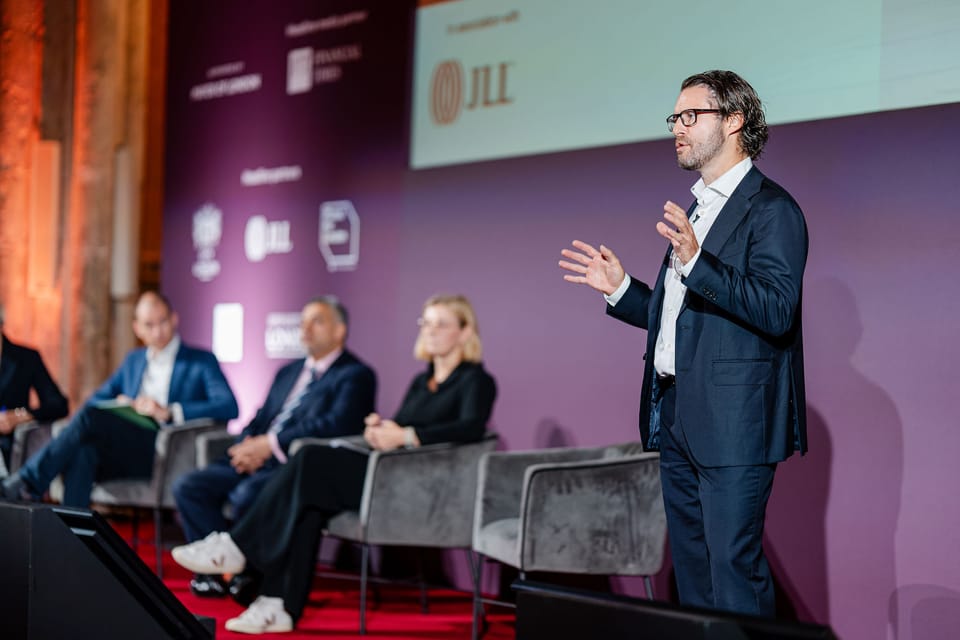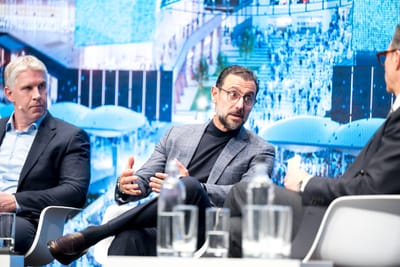
Speakers: Adam Challis (JLL), Tom Goodall (Related Argent), Kristy Lansdown (The Crown Estate), Emma Cariaga (British Land), Shravan Joshi MBE (City of London Corporation).
London’s real estate market is edging off the trough, but nobody on the keynote stage pretended the recovery will be quick or smooth. The message from JLL’s Adam Challis and a panel spanning development, long term stewardship, and City Hall was clear: sentiment is better, capital is circling, and offices are back on the buy list for some institutions. At the same time, viability, policy uncertainty, and delivery capacity remain the choke points. The way through is partnership that shares risk, targets long horizons, and ties delivery to infrastructure.
From “finding the bottom” to “selective risk on”
Challis set the tone. “We’re past the moment of maximum pessimism. Pricing has adjusted, and you can feel a selective return of risk appetite.” Transaction evidence is still uneven, yet Central London leasing has strengthened with several large pre lets, and prime new build vacancy is scarce. “Institutional interest is re-emerging for the right office product, future fit, low carbon, and well located,” he said. Logistics continues to outperform. Mixed use works where infrastructure is doing the heavy lifting and where owners can curate over time.
This is not a rising tide story. Macro conditions are supportive but not yet benign. The Bank of England held Base Rate at 4.0% on 18 September, and overnight SONIA has drifted down from early-year highs to the ~4% area, still materially above the last cycle’s lows. “Finance costs are still elevated, cost inflation hasn’t fully unwound, and planning timelines are stretching schemes beyond their carry,” Challis cautioned.
Viability is the pivot
Across the panel, viability was the most used word. Developers stressed that the maths remains unforgiving for complex projects, especially housing. “Demand has not gone away,” said Emma Cariaga. “What is missing is a viable route to delivery at scale.” Affordable housing asks, evolving building regulations, and uncertain net zero pathways all push costs up while values lag.
Kristy Lansdown added the long-term investor’s lens. “We can commit capital for decades, but we need stable rules of the game. Policy clarity reduces risk premiums more effectively than policy volume.” The Crown Estate is focusing on sequencing investment with enabling infrastructure and planning for decarbonisation in a way lenders and contractors can actually price.
Partnership as operating system
If there was a single through line, it was the need for public and private sectors to collaborate in practical ways. “Partnership is how we share risk at the front end and speed decisions,” said Tom Goodall of Related Argent. “On complex brownfield, you need land certainty, enabling utilities, transport commitments, and a clear, predictable decision tree. That de risks capital and shortens hold cost.”
From City Hall’s side, Shravan Joshi MBE framed the ask and the offer. “Our job is to unlock capacity through planning certainty and infrastructure, and to be honest about trade-offs. The private sector’s job is to bring patient capital and credible delivery plans.” Everyone agreed the market has enough capital, but not enough confidence in process. As one panellist put it, capital dislikes ambiguity more than it dislikes bad news.
Offices: polarisation intensifies
Challis’s read of the office market was sober but constructive. There is real, not just rhetorical, demand for high quality, energy efficient, amenity rich assets on strong transport. That is where institutional money is leaning back in. Secondary and tertiary space faces a protracted transition unless there is a credible route to deep retrofit or change of use.
“We need planning pathways that recognise the embodied carbon equation and the economic reality,” said Cariaga. “Refurbish where defensible, rebuild where essential, but give the market a way to make either stack.” Several examples cited on stage pointed to large scale retrofits that hard wire flexibility and ESG credentials into long lived buildings.
Housing: capacity trapped by costs and time
No one questioned the need for more homes. The debate focused on how to unlock them. London Plan targets still exceed actual delivery in many boroughs, and completions remain patchy. “Alignment on affordable expectations, utilities readiness, and transport phasing is make or break,” Goodall argued. “If policy sets targets detached from viability, schemes stall, and we deliver fewer affordable homes, not more.” The panel called for more transparent viability frameworks, pre agreed typologies on public land, and early-stage risk sharing such as enabling works and utilities upgrades, so projects can move from pipeline to shovel ready.
Infrastructure as multiplier
The session repeatedly returned to infrastructure as the force multiplier for growth: transport, grid, and social assets that turn planning consents into bankable projects. “Well sequenced infrastructure does three things,” Challis summarised. “It unlocks density, lowers delivery risk, and widens the buyer pool on exit.” The near term barometer will be whether funding lines and utilities connections move in step with housing and mixed-use phasing, since connection delays and uncertainty have become a chronic drag on programmes.
Capacity and confidence
Even if capital and policy line up, delivery capacity can still bottleneck. Skills tightness and contingency pricing keep tender’s firm. Insolvency risk upstream is another reason why prices remain sticky. “We need decisions faster, milestones that stick, and coordinated agencies,” said Cariaga. Joshi added that predictability builds trust. “If we consistently hit timetables, investment compounds.”
What investors say they need to re-engage
Four recurring asks came up across the hour.
- Policy certainty and consistency on affordable housing, building safety, and net zero requirements. This narrows risk premiums in underwriting and allows board level commitment.
- Faster, more predictable planning with clear gateways, accountable timelines, and fewer surprises late in the process.
- Risk sharing structures such as public land contributions, guarantees, and enabling infrastructure that de risk early phases and compress the cost of capital.
- Patient capital alignment that emphasises stewardship and multi cycle value creation rather than quarter to quarter optimisation. This is a precondition for deep retrofit and complex place making.
“Give us clarity and speed, and you will be surprised how quickly capital turns up,” Challis noted.
Outlook: a bumpy, investable recovery
No one predicts a snap back. The base case is a gradual and bumpy recovery with strong dispersion by sector and location. Logistics should stay resilient. Best in class offices have a bid. Housing depends on whether policy and viability can be reconciled at scale. The rate path will help at the margin, but the decisive variables are local: planning, utilities, and delivery.
Become a subscriber receive the latest updates in your inbox.






